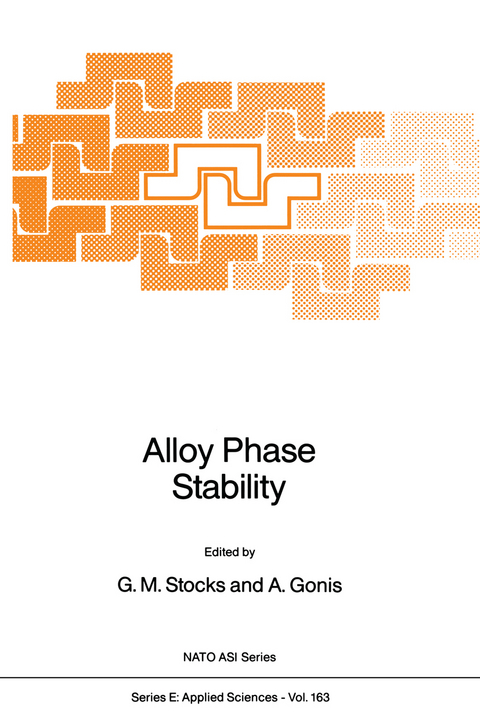
Alloy Phase Stability
Springer (Verlag)
978-94-010-6901-4 (ISBN)
One of the ultimate goals of materials research is to develop a fun damental and predictive understanding of the physical and metallurgical properties of metals and alloys. Such an understanding can then be used in the design of materials having novel properties or combinations of proper ties designed to meet specific engineering applications. The development of new and useful alloy systems and the elucidation of their properties are the domain of metallurgy. Traditionally, the search for new alloy systems has been conducted largely on a trial and error basis, guided by the skill and intuition of the metallurgist, large volumes of experimental data, the principles of 19th century thermodynamics and ad hoc semi-phenomenological models. Recently, the situation has begun to change. For the first time, it is possible to understand the underlying mechanisms that control the formation of alloys and determine their properties. Today theory can begin to offer guidance in predicting the properties of alloys and in developing new alloy systems. Historically, attempts directed toward understanding phase stability and phase transitions have proceeded along distinct and seemingly diverse lines. Roughly, we can divide these approaches into the following broad categories. 1. Experimental determination of phase diagrams and related properties, 2. Thermodynamic/statistical mechanical approaches based on semi phenomenological models, and 3. Ab initio quantum mechanical methods. Metallurgists have traditionally concentrated their efforts in cate gories 1 and 2, while theoretical physicists have been preoccupied with 2 and 3.
Alloy Phase Stability: Opening Remarks.- Section 1. Alloy Design.- Phase Stability and Alloy Design of Ordered Intermetallics.- Mechanical Properties and Phase Stability of Ll2Ni3A1 Ternary Compounds.- Ordered B2 Aluminides.- Section 2. Experimental Probes of Atomic and Electronic Structure.- Photoemission and the Study of Order-Disorder Transformations.- Electron Microscopy of Ordering in Alloys.- Quantitative Statistical Description of the Long Period Antiphase Boundary Structures from Their High Resolution Image.- Long-Range Order and Short-Range Order in Pd3V: Breakdown of the Mean Field Theory.- Long Period Superstructures in Cu3+xPd.- Long Period Superlattice Phases in Cu-Al-Zn Alloys.- New Antiphase Superstructures in Nb-Ga Binary System.- Order-Disorder Transition in CuPt-Alloys, Investigated by Resistivity Measurement.- Effective Pair-Interactions in Binary Alloys.- Section 3. Thermodynamics and Statistical Mechanics.- Computer Based Thermochemical Modeling of Multicomponent Phase Diagrams.- The Cluster Variation Method and the Calculation of Alloy Phase Diagrams.- Long Period Structures in Alloys-Statistical Mechanics of the ANNNI Model and Related Concepts.- Mechanisms for the Decay of Unstable and Metastable Phases: Spinodal Decomposition, Nucleation and Late-Stage Coarsening.- Monte Carlo Calculations of Phase Diagrams of Magnetic Alloys on the Body-Centered Cubic Lattice.- Hierarchy of Cluster Variational Methods on 3-Dimensional Lattices and Application to the Study of FCC Phase Diagrams.- A Criterion for Determining the Tricritical Point.- The Coordination Cluster Theory for Metallic Solutions.- Section 4. Electronic Theories of Phase Stability, Semi-Phenomenological and Model Hamiltonians.- Electronic Structure, Effective Pair Interactions and Order inAlloys.- Quantum Mechanics in Alloy Design.- Tight-Binding Hamiltonians.- Cluster Bethe Lattice Approach to Chemically Disordered Alloys with Short Range Order.- Section 5. Electronic Theories of Phase Stability: First Principles Theory.- Structural Stability of Intermetallic Compounds: A Computational Metallurgical Approach.- Electronic Structure and Magnetic Properties of Impurities in Metals.- The Electronic Structure and the State of Compositional Order in Metallic Alloys.- Local Density Theory of Magnetism and Its Interrelation with Compositional Order in Alloys.- Configurational Energies in Terms of Effective Cluster Interactions in Binary Substitutional Alloys: Connection Between the Embedded Cluster Method and the Generalized Perturbation Method.- Cluster Interactions and Thermodynamic Properties of Al-Transition Metal Alloys.- Electronic Theory of Phase Stability in Substitutional Alloys: A Comparison on Between the Connolly-Williams Scheme and the Generalized Perturbation Method.- Section 6. The Effects of Strain and Macroscopic Defects on Phase Stability.- Strain Controlled Morphologies in the Two-Phase State.- The Influence of Lattice Defects on Alloy Phase Diagrams.- Phase Stability by the Artificial Concentration Wave Method.- Growth Modes and Metastability in Cu-Ni and Pd-Ni Compositionally Modulated Thin Films.- Premartensitic Microstructures as Seen in the High Resolution Electron Microscope: A Study on a Ni-Al Alloy.- Section 7. General Topics.- Annihilation Momentum Density of Positrons Trapped at Vacancy-Type Defects in Metals and Alloys.- Electronic Structure, Charge Transfer Excitations and High Tc Superconductivity in Transition Metal Oxides.- Electronic and Structural Properties of Ordered III–V Alloys.- Liquid Alloys — New Perspectives andChallenges.- Excitation Spectra of Optically Excited Rare-Gas Atoms Physisorbed on Metal Surfaces.- Dynamics of Spinodal Decomposition in Polymer Gels.- Closing Address.- List of Lecturers.- List of Participants.- Author Index.
| Reihe/Serie | NATO Science Series E ; 163 |
|---|---|
| Zusatzinfo | 672 p. |
| Verlagsort | Dordrecht |
| Sprache | englisch |
| Maße | 155 x 235 mm |
| Themenwelt | Mathematik / Informatik ► Informatik ► Theorie / Studium |
| Naturwissenschaften ► Physik / Astronomie ► Atom- / Kern- / Molekularphysik | |
| Naturwissenschaften ► Physik / Astronomie ► Festkörperphysik | |
| Naturwissenschaften ► Physik / Astronomie ► Mechanik | |
| Naturwissenschaften ► Physik / Astronomie ► Thermodynamik | |
| Technik ► Maschinenbau | |
| ISBN-10 | 94-010-6901-8 / 9401069018 |
| ISBN-13 | 978-94-010-6901-4 / 9789401069014 |
| Zustand | Neuware |
| Informationen gemäß Produktsicherheitsverordnung (GPSR) | |
| Haben Sie eine Frage zum Produkt? |
aus dem Bereich


